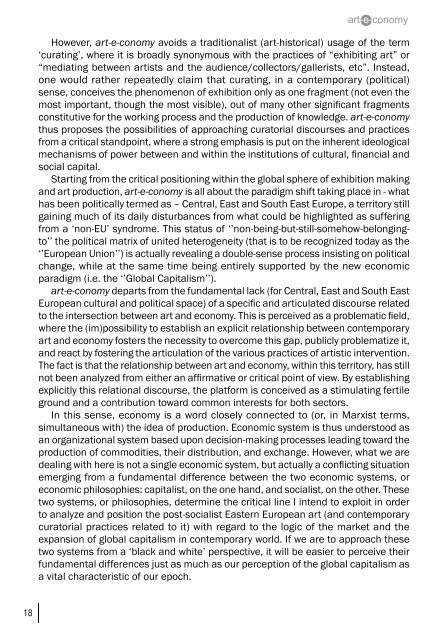art-e-conomy _ reader - marko stamenkovic
art-e-conomy _ reader - marko stamenkovic
art-e-conomy _ reader - marko stamenkovic
Create successful ePaper yourself
Turn your PDF publications into a flip-book with our unique Google optimized e-Paper software.
18<br />
However, <strong>art</strong>-e-<strong>conomy</strong> avoids a traditionalist (<strong>art</strong>-historical) usage of the term<br />
‘curating’, where it is broadly synonymous with the practices of “exhibiting <strong>art</strong>” or<br />
“mediating between <strong>art</strong>ists and the audience/collectors/gallerists, etc”. Instead,<br />
one would rather repeatedly claim that curating, in a contemporary (political)<br />
sense, conceives the phenomenon of exhibition only as one fragment (not even the<br />
most important, though the most visible), out of many other significant fragments<br />
constitutive for the working process and the production of knowledge. <strong>art</strong>-e-<strong>conomy</strong><br />
thus proposes the possibilities of approaching curatorial discourses and practices<br />
from a critical standpoint, where a strong emphasis is put on the inherent ideological<br />
mechanisms of power between and within the institutions of cultural, financial and<br />
social capital.<br />
St<strong>art</strong>ing from the critical positioning within the global sphere of exhibition making<br />
and <strong>art</strong> production, <strong>art</strong>-e-<strong>conomy</strong> is all about the paradigm shift taking place in - what<br />
has been politically termed as – Central, East and South East Europe, a territory still<br />
gaining much of its daily disturbances from what could be highlighted as suffering<br />
from a ‘non-EU’ syndrome. This status of ‘’non-being-but-still-somehow-belongingto’’<br />
the political matrix of united heterogeneity (that is to be recognized today as the<br />
‘’European Union’’) is actually revealing a double-sense process insisting on political<br />
change, while at the same time being entirely supported by the new economic<br />
paradigm (i.e. the ‘’Global Capitalism’’).<br />
<strong>art</strong>-e-<strong>conomy</strong> dep<strong>art</strong>s from the fundamental lack (for Central, East and South East<br />
European cultural and political space) of a specific and <strong>art</strong>iculated discourse related<br />
to the intersection between <strong>art</strong> and e<strong>conomy</strong>. This is perceived as a problematic field,<br />
where the (im)possibility to establish an explicit relationship between contemporary<br />
<strong>art</strong> and e<strong>conomy</strong> fosters the necessity to overcome this gap, publicly problematize it,<br />
and react by fostering the <strong>art</strong>iculation of the various practices of <strong>art</strong>istic intervention.<br />
The fact is that the relationship between <strong>art</strong> and e<strong>conomy</strong>, within this territory, has still<br />
not been analyzed from either an affirmative or critical point of view. By establishing<br />
explicitly this relational discourse, the platform is conceived as a stimulating fertile<br />
ground and a contribution toward common interests for both sectors.<br />
In this sense, e<strong>conomy</strong> is a word closely connected to (or, in Marxist terms,<br />
simultaneous with) the idea of production. Economic system is thus understood as<br />
an organizational system based upon decision-making processes leading toward the<br />
production of commodities, their distribution, and exchange. However, what we are<br />
dealing with here is not a single economic system, but actually a conflicting situation<br />
emerging from a fundamental difference between the two economic systems, or<br />
economic philosophies: capitalist, on the one hand, and socialist, on the other. These<br />
two systems, or philosophies, determine the critical line I intend to exploit in order<br />
to analyze and position the post-socialist Eastern European <strong>art</strong> (and contemporary<br />
curatorial practices related to it) with regard to the logic of the market and the<br />
expansion of global capitalism in contemporary world. If we are to approach these<br />
two systems from a ‘black and white’ perspective, it will be easier to perceive their<br />
fundamental differences just as much as our perception of the global capitalism as<br />
a vital characteristic of our epoch.


